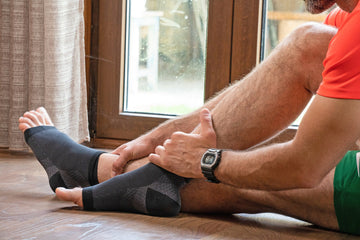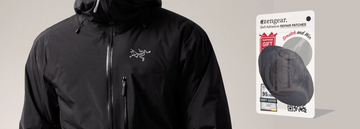Die häufigsten Ursachen für Knöchelverstauchungen: Tipps zur Linderung
von {{ author }} Emily Jannet an Aug 17, 2024
Knöchelverstauchungen gehören zu den häufigsten Verletzungen und betreffen Sportler, aktive Menschen und sogar Menschen, die alltäglichen Aktivitäten nachgehen. Die Verletzung tritt typischerweise auf, wenn die Bänder, die den Knöchel stützen, über ihre Grenzen hinaus gedehnt werden und reißen. Das Verständnis der Ursachen von Knöchelverstauchungen und der effektiven Behandlung von Knöchelschmerzen, einschließlich der Verwendung von Knöchelbandagen, ist für die Vorbeugung und Genesung von entscheidender Bedeutung.
Häufige Ursachen für Knöchelverstauchungen
Plötzliche Drehbewegungen
Ein schneller Richtungswechsel oder eine plötzliche Drehung kann dazu führen, dass der Fuß nach innen oder außen knickt und die Bänder überdehnt werden. Dies ist häufig bei Sportarten wie Basketball, Fußball und Tennis zu beobachten, bei denen schnelle Seitwärtsbewegungen häufig vorkommen.
Unebene Oberflächen
Beim Gehen oder Laufen auf unebenem Untergrund steigt das Risiko einer Knöchelverstauchung. Wege mit Steinen, Löchern oder unebenem Belag können zu einem ungünstigen Aufsetzen des Fußes führen, was zu einer Verdrehung oder Drehung führt, die die Bänder verletzt.
Falsches Schuhwerk
Das Tragen von Schuhen, die keinen ausreichenden Halt bieten oder für die jeweilige Aktivität ungeeignet sind, kann zu einer Instabilität des Knöchels führen. Hohe Absätze beispielsweise können leicht zum Umknicken des Knöchels führen, während Sportschuhe, die keinen ausreichenden Halt und Halt bieten, das Risiko bei körperlicher Aktivität erhöhen können.
Schwache oder unausgeglichene Muskeln
Die Muskeln um Knöchel und Fuß sorgen für die notwendige Unterstützung des Gelenks. Wenn diese Muskeln schwach oder unausgeglichen sind, ist der Knöchel anfälliger für Verstauchungen. Diese Schwäche kann durch Inaktivität, falsches Training oder einen Mangel an Kraft- und Konditionsübungen verursacht werden.
Vorherige Verletzungen
Eine Vorgeschichte von Knöchelverstauchungen kann das Gelenk anfälliger für zukünftige Verletzungen machen. Bänder, die zuvor gedehnt oder gerissen wurden, heilen möglicherweise nicht richtig, was zu chronischer Instabilität und einem höheren Risiko für erneute Verstauchungen führt.
Überbeanspruchung
Wiederholte Belastungen des Knöchels, wie sie beim Langstreckenlauf und anderen Ausdauersportarten häufig vorkommen, können die Bänder mit der Zeit schwächen. Überlastungsverletzungen sind oft die Folge davon, dass zwischen intensiven Aktivitäten nicht genügend Erholungszeit eingeräumt wird.
Linderung von Knöchelschmerzen mit Knöchelbandagen
Knöchelbandagen, auch Knöchelstützen oder -stützen genannt, sind dazu gedacht, das Sprunggelenk zu komprimieren, zu stützen und zu stabilisieren. Sie werden häufig sowohl zur Vorbeugung als auch zur Behandlung von Knöchelverstauchungen eingesetzt. So können Knöchelbandagen Knöchelschmerzen lindern und die Genesung unterstützen:
Kompression
Knöchelbandagen üben sanften, gleichmäßigen Druck auf den Knöchel aus, was Schwellungen und Entzündungen lindern kann. Die Kompression erhöht die Durchblutung in diesem Bereich und fördert eine schnellere Heilung, indem sie beschädigtes Gewebe mit Sauerstoff und Nährstoffen versorgt. Darüber hinaus hilft sie beim Abtransport von Stoffwechselabfallprodukten von der Verletzungsstelle.
Unterstützung und Stabilisierung
Knöchelbandagen bieten dem Gelenk eine äußere Stütze, helfen, es zu stabilisieren und weiteren Verletzungen vorzubeugen. Dies ist besonders für Personen mit schwachen oder bereits verletzten Knöcheln von Vorteil, da die zusätzliche Stütze übermäßige Bewegungen verhindern kann, die zu einer weiteren Verstauchung führen könnten.
Schmerzlinderung
Die Kompression und Unterstützung durch Knöchelbandagen kann Schmerzen deutlich lindern. Indem sie den Bewegungsbereich einschränken und Bewegungen verhindern, die die Verletzung verschlimmern, lindern Knöchelbandagen Beschwerden und ermöglichen dem Betroffenen, sich bequemer zu bewegen.
Verbesserte Propriozeption
Propriozeption bezeichnet die Fähigkeit des Körpers, seine Position im Raum zu spüren. Knöchelbandagen verbessern die propriozeptive Rückmeldung, was zu einer Verbesserung von Gleichgewicht und Koordination beitragen kann. Dies ist insbesondere während der Rehabilitation wichtig, da eine verbesserte Propriozeption dabei hilft, die volle Funktion des Knöchels wiederherzustellen und das Risiko künftiger Verstauchungen zu verringern.
Vielseitigkeit und Komfort
Knöchelbandagen sind vielseitig einsetzbar und können bei verschiedenen Aktivitäten getragen werden, darunter beim Sport, bei alltäglichen Aufgaben und sogar beim Schlafen, um kontinuierliche Unterstützung zu bieten. Sie bestehen normalerweise aus atmungsaktiven, leichten Materialien und sorgen so für Komfort bei längerem Tragen. Das einfache An- und Ausziehen von Knöchelbandagen macht sie zu einer praktischen Option für alle, die sofortige Linderung von Knöchelschmerzen suchen.
Die richtige Knöchelmanschette auswählen
Bei der Auswahl einer Knöchelbandage müssen folgende Faktoren berücksichtigt werden:
- Stützgrad: Verschiedene Knöchelbandagen bieten unterschiedliche Stützgrade, von leichter Kompression bei leichten Verstauchungen bis hin zu starren Stützen bei schweren Verletzungen. Wählen Sie eine Bandage, die dem Schweregrad Ihrer Erkrankung und dem Aktivitätsniveau entspricht, das Sie planen.
- Material: Achten Sie auf atmungsaktive, feuchtigkeitsableitende Materialien, die bequem sind und Hautreizungen vorbeugen. Neopren und elastische Stoffe werden häufig für hochwertige Knöchelbandagen verwendet.
- Passform und Größe: Eine gute Passform ist entscheidend für effektiven Halt und Komfort. Messen Sie Ihren Knöchel und befolgen Sie die Größenrichtlinien des Herstellers, um sicherzustellen, dass Sie die richtige Größe wählen.
- Benutzerfreundlichkeit: Bedenken Sie, wie einfach es ist, die Knöchelmanschette an- und auszuziehen, insbesondere wenn Sie sie häufig oder bei Aktivitäten verwenden möchten.
Knöchelverstauchungen sind eine häufige, aber vermeidbare Verletzung, die oft durch plötzliche Bewegungen, unebene Oberflächen, falsches Schuhwerk, schwache Muskeln, frühere Verletzungen und Überbeanspruchung verursacht wird. Das Verständnis dieser Ursachen kann den Betroffenen helfen, vorbeugende Maßnahmen zu ergreifen. Im Falle einer Verletzung bieten Knöchelbandagen eine wirksame Möglichkeit, Schmerzen zu lindern und die Genesung durch Kompression, Unterstützung und verbesserte Propriozeption zu erleichtern. Indem Sie die richtige Knöchelbandage auswählen und in Ihre Genesungsroutine integrieren, können Sie Schmerzen lindern, weiteren Verletzungen vorbeugen und selbstbewusst zu Ihren Aktivitäten zurückkehren.





